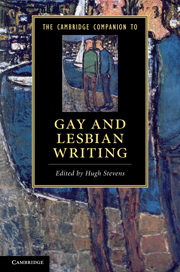Book contents
- Frontmatter
- Homosexuality and literature: an introduction
- Part I Repression and Legitimation
- Part II Affiliations
- 6 The homoerotics of travel: people, ideas, genres
- 7 The queerness of race and same-sex desire
- 8 The literature of AIDS
- 9 Transgender fiction and politics
- Part III Literary Traditions
- Guide to further reading
- Index
9 - Transgender fiction and politics
from Part II - Affiliations
Published online by Cambridge University Press: 28 January 2011
- Frontmatter
- Homosexuality and literature: an introduction
- Part I Repression and Legitimation
- Part II Affiliations
- 6 The homoerotics of travel: people, ideas, genres
- 7 The queerness of race and same-sex desire
- 8 The literature of AIDS
- 9 Transgender fiction and politics
- Part III Literary Traditions
- Guide to further reading
- Index
Summary
“'Very well - what is this love we have for the invert - boy or girl? It was they who were spoken of in every romance that we ever read . . . They go far back in our lost distance . . . They are our answer to what our grandmothers told us love was, and what it never came to be; they, the living lie of our centuries.'” / This meditation on the curious appeal of the invert is addressed by Doctor MatthewO'Connor to the lovelorn Nora Flood in Djuna Barnes's 1937 novel Nightwood. Nightwood is generally read as a classic in lesbian and gay literature, and for good reason. The object of Nora's 'miscalculated longing' is the faithless Robin Vote, who has abandoned her to wander the Paris underworld and, ultimately, to take up with another woman, involving Nora in a lesbian triangle. O'Connor is familiar with the homosexual demimonde, and in particular with the Paris pissoirs where he cruises other men. Though Nightwood is full of representations of same-sex desire, it would be possible to describe it not as a novel of homosexuality but rather as a novel of gender variance. In an earlier scene, Nora goes to the Doctor's room to seek advice and finds him lying in bed 'in a woman's flannel nightgown' (79), wearing a blond curly wig and heavy makeup. The doctor explains his taste for cottaging with reference to a bungled act of reincarnation: 'I've turned up this time as I shouldn't have been', he says, and muses that 'in the old days I was possibly a girl in Marseilles thumping the dock with a sailor' (90-1). We might want to see Nora's desire for Robin as something other than same-sex desire: her declaration that she 'chose a girl who resembles a boy' prompts the Doctor's meditation on the allure of the invert.
- Type
- Chapter
- Information
- The Cambridge Companion to Gay and Lesbian Writing , pp. 148 - 164Publisher: Cambridge University PressPrint publication year: 2010

